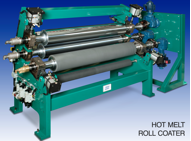The following is part one of a series of 3 blogs that will go through a white paper written by New Era Converting Machinery’s Tom Lombardo and Bob Pasquale. The white paper is titled “Methods and Design Considerations for the Application of Hot Melt Coatings.”
Part 1 will offer an overview of the entire paper and what to expect in coming blogs. Part 2 will give a detailed account of various coating application methods. Part 3 will wrap the series up with design considerations in hot melt application systems and offer a brief conclusion.
—–
Part 1: Introduction and Background
INTRODUCTION:
 As the use of hot melt coatings continues to grow and evolve so too have the operating parameters and requirements for applying these coatings. This article covers several of the coating methods currently used to apply hot melts, including a review of the typical operating parameters and conditions for each method. as well as the associated advantages or disadvantages. Additionally, we discuss the critical features that should be incorporated into the design of the application system. Though we touch upon the systems that are used to melt and deliver the hot melts to the coater, we do not cover them in any detail.
As the use of hot melt coatings continues to grow and evolve so too have the operating parameters and requirements for applying these coatings. This article covers several of the coating methods currently used to apply hot melts, including a review of the typical operating parameters and conditions for each method. as well as the associated advantages or disadvantages. Additionally, we discuss the critical features that should be incorporated into the design of the application system. Though we touch upon the systems that are used to melt and deliver the hot melts to the coater, we do not cover them in any detail.
BACKGROUND:
Typical hot melt coatings have two distinct characteristics which set them apart from other forms of coatings. First, they are a 100% solid coating, which eliminates the need to remove any solvent or water carriers in a post application process. Second, they are in a solid form at room temperature, transitioning to a liquid state as heat is applied, with their viscosities reducing as the temperature increases. The relationship between temperature and viscosity varies based upon the chemical composition of the coating, with viscosities as low as 5 cps (0.005 Pa·s) and as high as 250,000 cps (250 Pa·s). Typical application temperatures range from 200°F to 400°F, though certain coatings are applied at lower or higher temperatures.
For purposes of this article we do not consider waxes or wax based coatings, even though they do meet the above parameters. We also do not cover those coatings which are thermoplastic in nature and are applied by extrusion coating.
###
*Click here to read the second blog in the series, or check back soon for the final blog in the series!*













 Downloadable Brochures in PDF Format
Downloadable Brochures in PDF Format